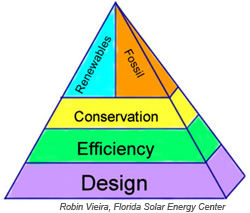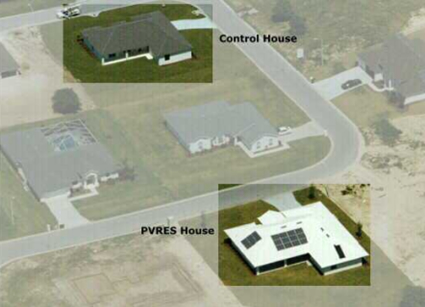
Reference Publication: Vieira, R., "The Energy Policy Pyramid - A Hierarchal Tool For Decision Makers"., Fifteenth Symposium on Improving Building Systems in Hot and Humid Climates, July 24-26, 2006 Orlando, FL. Disclaimer: The views and opinions expressed in this article are solely those of the authors and are not intended to represent the views and opinions of the Florida Solar Energy Center. |
The
Energy Policy Pyramid -
A Hierarchal Tool For Decision Makers
Robin K. Vieira, Director, Building
Research Division
Florida
Solar Energy Center (FSEC)
FSEC-PF-401-06
 |
Figure 1. The
Energy Policy Pyramid Presents Hierarchy with the Most Cost-Effective Energy Policies at the Base of the Pyramid |
Abstract
Policies of dealing with energy programs are often misdirected. Decision makers jump first to fuel substitution to either lower emissions or counter fuel price escalation. When it comes to both return on short-term economic investment and long-term sustainability for the economy and environment, there is a clear hierarchy. This paper presents the hierarchy as The Energy Policy Pyramid©.
Introduction
The Energy Policy Pyramid shows five levels of strategies to employ to reduce energy use. Policy should start with the foundation of the pyramid and work upwards, much like diet should consist more of food from the base of the USDA Food Guide Pyramid.
Invest in Designing it Right
The greatest potential for savings and the most cost-effective strategies often originate in design. Whether it is conceiving a building to make use of appropriate solar orientation, or land use planned to minimize transportation distances, or the development of a manufacturing process that includes minimizing energy use, it is during the design stage that the highly cost-effective strategies for making an impact are selected. Furthermore, such options, when ignored, represent “lost opportunities” that are impossible or cost prohibitive to achieve later in the project’s life. Design measures, whether done poorly or well, tend to persist for long durations, often for the entire life of the development, building, equipment or process. Good design requires access to good information and appropriate education for the designer. It can be encouraged through education, regulations and incentives.
Efficiency Delivers Benefits Without Inconvenience
Beyond the design stage, there are a number of efficiency measures that can be utilized. Efficiency measures provide the same or better benefit at no inconvenience to the user. An automobile that obtains ten percent better gas mileage than another vehicle in the same class with similar features is an example of efficiency in transportation. Replacing a motor with one that does the same work with less energy input is an example of improving efficiency in an industrial process. Selecting a more energy-efficient air conditioning system that produces the same amount and quality of cooling, while using far less energy, is an example of efficiency in a building. Once efficiency measures are made, they tend to be persistent until the item needs to be replaced. Creating more efficient technologies requires basic and applied research. Demonstrations, dissemination and education are required to begin market transformation. Regulation with enforcement can sometimes assures a minimum standard of efficiency.
Performance Standards Combine Design And Efficiency
Performance standards often allow trade-offs between efficiency and design. Prescriptive building codes dictate minimum efficiency levels for each building component whereas performance-based codes allow improved design features to substitute for higher levels of efficiency. Performance-based codes therefore incorporate a sounder foundation of the pyramid – good design will persist longer than the components. Thus over a building’s lifetime, the equipment, windows, and light fixtures may be improved and the building will perform at a higher level; but even with similar improved components, a prescriptive code building might not ever perform at the level of the building with the better design.
Conservation
Conservation initiatives involve reducing energy use, often with a change in occupant behavior. This differentiates conservation from the definition of efficiency described above. Examples include turning off lights when leaving a room, setting back a thermostat, participating in a van pool, and turning off a motor that is not in use. Although some conservation efforts are automated (e.g., motion sensors on light controls), others require continued consumer persistence for the savings to remain. Even with some automated controls, such as motion sensors or programmable thermostats, there is potential that the user will override the conservation feature. Regular consumer education is required for conservation efforts to have large, persistent impacts, although conservation behaviors increase with energy prices.
Alternative Fuels and Renewable Energy Systems
Alternative/renewable energy technologies look at supplying energy from resources that offer some benefit (such as less CO2 production) as compared with conventional resources and, as such, should be considered prior to or in conjunction with conventional resources. Roof-integrated photovoltaics, hydrogen- powered vehicles or wind-powered water pumps are examples of alternative energy supply methods. Note that they do not necessarily reduce energy use, but rather reduce use of some conventional energy fuel. Because these commodities, like all energy resources, are very valuable (and often costly), they should be considered only after all of the design, efficiency and conservation potential have been exhausted. Research and capital expense for infrastructure or demonstrations are generally required in the early stages of some alternative technologies. Others require some incentive to overcome institutional and market barriers; such incentives often are justified based on the environmental benefit derived.
Embrace Performance, Not A Given Technology
The use of policy to push technology needs to be performance based. Solar thermal systems typically convert 60 to70% of the sun’s incident radiation to useful energy. Commercially-installed silicon cell solar electric systems convert about 10% of the solar energy into useful electricity. Thus it would be unwise to create policies that push photovoltaics for buildings but ignore solar thermal systems. Building codes, voluntary green standards and state rebate programs need to reward based on performance, not simply targeting a technology. For example policies that simply create incentives to purchase hybrid technology cars should instead reward buyers of clean fuel-efficient cars under a system of energy usage per mile and emissions. A hybrid Hummer may still only achieve one-third the gas mileage of a gasoline Honda Civic.
Policy makers often fail to account for all costs of fuel choices. The cost and benefit of the alternative in both an energy accounting system based on Btus (Joules) as well as pollution and other benefits must be considered. In this decade, hydrogen has been championed as an energy solution. There are still many concerns about production, storage and distribution (Rohm, 2004), and at the present time hydrogen is generated by burning natural gas. Natural gas used directly for certain end-uses may be preferred to converting natural gas to hydrogen due to the inefficiencies of conversion and the energy costs of storage and distribution of hydrogen. Hydrogen may be a fuel that allows for clean-burning transportation in urban areas in this century. It is less likely to reduce our overall needs for fossil fuels. This is not to discount the potential for hydrogen, but it is to point out that policy must not be myopic in view. Ethanol sources, solar equipment and off-shore wind should all undergo full life cycle accounting if the goal is to reduce the need for conventional energy sources. Estimates of energy payback of solar photovoltaic systems is estimated at 2 to 11 years (Blakers and Weber, 2000).Before claiming a given fuel or technology will deliver us from our energy and environmental woes, a cradle to cradle accounting of Btus and environmental consequences (McDonough, 2000) must be considered and the fuel source must match its end-use.
Choose Conventional Fuels That Best Fit the End Use
Finally, conventional fossil-fuel resources should be explored to meet the needs in such a way as to assure cost-effectiveness and reliability. Even among conventional fossil-fuel choices there may be preferences for one of the options based on efficiency, emissions and application for particular tasks.
Combine Pyramid Strategies to Achieve High Performance
These types of strategies can be segmented, but sometimes
the differentiation may be difficult. More importantly, there tend to
be groups of measures from all of these categories that complement each
other and work in synergistic ways.
The Lakeland Florida Zero Energy Home project (Parker, et. al., 1998)
exemplifies combining the pyramid steps to achieve efficiency. The project
evolved from an exercise in all of the cost-effective measures one should
incorporate prior to spending money on photovoltaics (Parker and Dunlop,
1994). Designed to demonstrate what was technically achievable, FSEC and
Lakeland Electric compared a builder’s standard model with one upgraded
and supplied with photovoltaics. First, the design was
altered to include ductwork inside the conditioned.

Figure 2. The Lakeland Zero Energy
Home Project (Control Home had Dark Shingles)
Followed Many of the Principles Described in The Energy Policy Pyramid
Efficiency measures included better wall and ceiling
insulation, efficient windows and appliances and very efficient heating
and cooling systems. Conservation efforts included
programmable thermostats. A solar water heating
system was deployed. By incorporating all the measures, the model
used just 30% of the energy for cooling as the comparison home. The
2400-square-foot zero energy home met the peak cooling requirements
during the summer of 1998 with a two-ton AC system while the control
home built to code could not maintain the temperature with a four-ton
unit. Due to the base pyramid reduction efforts, 4kW of photovoltaics
were added that displaced the majority of the remaining electrical
demand of the cooling system. Conventional gas appliances
were used to further reduce electrical demand.

Figure 3. The
Home Reduced Cooling Loads by 70% through design and efficiency measures
allowing the 4kW
of photovoltaics to provide the majority of the remainder of the cooling
during the record hot summer of 1998
Compare Design, Efficiency And Conservation Measure Cost-Effectiveness To The Life-Cycle Cost Of The Fuel Used
The Lakeland home demonstrates many strategies that could be employed more cost effectively than adding more photovoltaics. Thus, policy should examine the lower levels of the pyramid against the costs of the renewable and conventional resources to be used.
Conclusion
All too often, decisions made by policy makers concentrate on the supply of conventional sources without examining the great benefit available from the more cost-effective pyramid blocks that take place at each end-use sector. There is no quick fix to energy policy and resources must be allocated wisely. Resources should be allocated to performance of designs, then efficiency measures, then conservation, alternative and conventional fuels. The Energy Policy Pyramid can serves as a tool for policy decision makers.
References
Blakers, Andrew and Klaus Weber, 2000. “The Energy Intensity of Photovoltaic Systems.” Center For Sustainable Energy Systems, Engineering Department, Australian National University, Canberra 0200, October.
McDonough, William and Michael Braungart, 2002, Cradle to Cradle, North Point Press, 2002
Parker, D.S., J.P. Dunlop, S.F. Barkaszi, Jr., J.R. Sherwin and M.P. Anello, 2000, "Towards Zero Energy Demand: Evaluation of Super Efficient Building Technology with Photovoltaic Power for New Residential Housing." 2000 Summer Study on Energy Efficiency in Buildings, Vol. 3, American Council for an Energy Efficient Economy, Washington, DC.
Parker, D.S. and James P. Dunlop, 1994. “Solar Photovoltaic Air Conditioning of Residential Buildings.” 1994 Summer Study on Energy Efficiency in Buildings, Vol. 3, American Council for an Energy Efficient Economy, Washington, DC.
Rohm, Joseph J., 2004, The Hype About Hydrogen: Fact and Fiction in the Race to Save the Climate, Island Press
